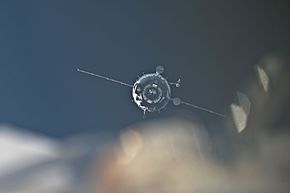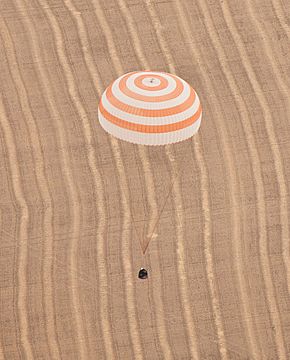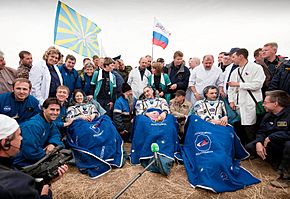Soyuz TMA-18 facts for kids
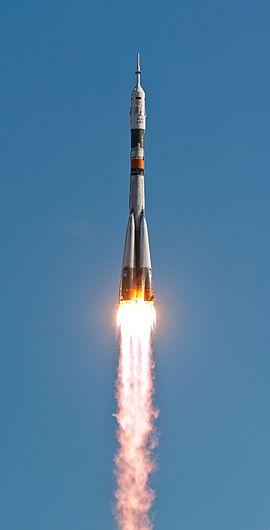
Soyuz TMA-18 launches from Baikonur Cosmodrome, 2 April 2010.
|
|
| Mission type | Crewed mission to ISS |
|---|---|
| Operator | Roscosmos |
| Mission duration | 176 days |
| Spacecraft properties | |
| Spacecraft type | Soyuz TMA 11F732 |
| Manufacturer | RKK Energia |
| Crew | |
| Crew size | 3 |
| Members | Aleksandr Skvortsov Mikhail Kornienko Tracy Caldwell Dyson |
| Callsign | утес ("cliff") |
| Start of mission | |
| Launch date | 2 April 2010, 04:04 UTC |
| Rocket | Soyuz-FG |
| Launch site | Baikonur, Site 1/5 |
| End of mission | |
| Landing date | 25 September 2010, 05:23 UTC |
| Orbital parameters | |
| Reference system | Geocentric orbit |
| Regime | Low Earth orbit |
| Inclination | 51.66° |
| Docking with ISS | |
| Docking port | Poisk zenith |
| Docking date | 4 April 2010, 05:25 UTC |
| Undocking date | 25 September 2010 02:02 UTC |
| Time docked | 173 days, 20 hours and 37 minutes |
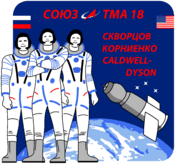 Soyuz TMA-18 mission patch 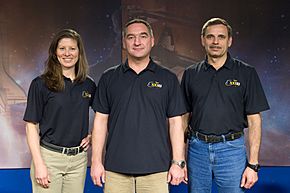 From left to right: Caldwell Dyson, Skvortsov and Kornienko Soyuz programme
(Crewed missions) |
|
Soyuz TMA-18 was a space mission that took three astronauts to the International Space Station (ISS) in 2010. It was part of the Soyuz programme, which sends people to space. This flight was the 105th time a Soyuz spacecraft carried a crew since the first one in 1967. The mission lasted for 176 days.
Contents
Meet the Crew
Three space travelers were on board Soyuz TMA-18. They were part of a team called Expedition 23 on the ISS.
| Position | Crew member | |
|---|---|---|
| Commander | Expedition 23 First spaceflight |
|
| Flight Engineer 1 | Expedition 23 First spaceflight |
|
| Flight Engineer 2 | Expedition 23 Second spaceflight |
|
Backup Crew
Just like in sports, space missions have backup teams. These astronauts train in case the main crew cannot fly.
| Position | Cosmonaut | |
|---|---|---|
| Commander | ||
| Flight Engineer 1 | ||
| Flight Engineer 2 | ||
The Launch
The Soyuz TMA-18 spacecraft launched successfully on April 2, 2010. It carried Commander Aleksandr Skvortsov, Mikhail Kornienko, and NASA astronaut Tracy Caldwell Dyson. They were heading to the International Space Station.
Skvortsov sat in the middle of the Soyuz capsule. Kornienko was on his left, and Caldwell Dyson was on his right. The launch went perfectly.
Right after launch, there was a small problem with communications. Mission control in Russia could not talk to the crew. But a camera inside the spacecraft showed everyone was safe. After nine minutes, the Soyuz reached its first orbit around Earth. It also opened its solar panels to get power. The spacecraft then spent two days slowly getting closer to the ISS.
Getting Ready for Launch
Before the launch, a lot of work went into preparing the rocket and spacecraft. For months, experts tested all the systems. They checked the Kurs docking system and the computer inside the Soyuz.
The Soyuz TMA-18 spacecraft was also tested in a special vacuum chamber. This made sure it could handle space conditions. Workers at the TsSKB-Progress and Yuzhny Space Center put together the Soyuz-FG launch rocket.
The main and backup crews arrived at the Baikonur Cosmodrome on March 21, 2010. This is the launch site in Kazakhstan. On March 31, 2010, the Soyuz FG rocket, with the Soyuz TMA-18 spacecraft on top, was moved to Launch Pad 1. It was then set upright, ready for its journey to space.
Docking with the ISS
On April 4, 2010, the Soyuz TMA-18 successfully connected, or "docked," with the Poisk module of the ISS. This happened at 05:25 UTC. The spacecraft connected three minutes earlier than planned.
After the Soyuz touched the ISS, special hooks and latches automatically closed. This made sure the two spacecraft were tightly connected. The crew then checked for any air leaks between the Soyuz and the ISS.
About an hour and 45 minutes later, the hatches between the Soyuz and the ISS were opened. The three crew members moved into their new home in space. A welcome ceremony was held, with family members watching from Russia. The Soyuz spacecraft stayed connected to the ISS. It served as an emergency escape vehicle for the astronauts during their time on the station.
Undocking Problems
The crew was supposed to return to Earth on September 24, 2010. But they had trouble disconnecting the Soyuz spacecraft from the ISS. This meant their landing had to be delayed.
On September 23, 2010, the crew went into the Soyuz TMA-18 and closed the main hatch. But they couldn't get a tight seal. They had to open the hatch to check it. The hatch was sealed again, but there was still a problem with the connection to the ISS.
When commands were sent to open the hooks on the Poisk module, nothing happened. An astronaut on the ISS even found a small gear floating from the mechanism. Because of this problem, the undocking was called off. The Soyuz TMA-18 crew took off their space suits and went back into the space station.
Landing Back on Earth
After the delay, Skvortsov, Kornienko, and Caldwell Dyson successfully undocked their Soyuz TMA-18. This happened at 02:32 UTC on September 25, 2010.
The spacecraft then began its journey back to Earth. After a normal descent, the Soyuz TMA-18 landed at 05:23 UTC. It touched down near Arkalyk, Kazakhstan. At that moment, the International Space Station was orbiting 350 kilometers above the Pacific Ocean.
Russian recovery teams and helicopters were waiting at the landing site. They helped the crew get out of the spacecraft. It took some time for the astronauts to get used to Earth's gravity again after 176 days in space.
Mission Patch
The special design for the Soyuz TMA-18 mission, called a patch, was created by Nastya Berezutskaya. She is from Kurchatov, in the Kursk region of Russia.


